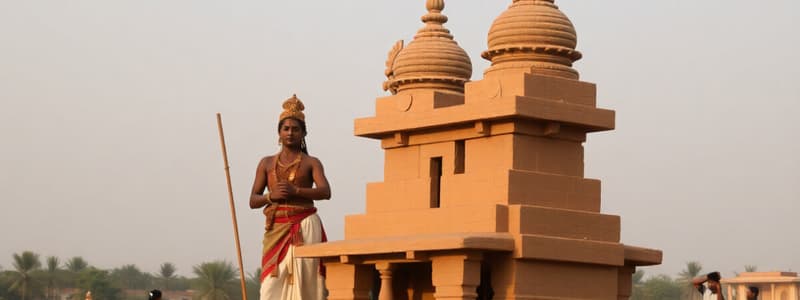Podcast
Questions and Answers
What event marked Siddhartha Gautama's journey towards enlightenment?
What event marked Siddhartha Gautama's journey towards enlightenment?
- His marriage
- His encounter with a monk (correct)
- His departure from his palace (correct)
- His royal coronation
Which teaching of Buddhism focuses on understanding suffering?
Which teaching of Buddhism focuses on understanding suffering?
- The Twelve Steps
- The Law of Attraction
- The Eightfold Path
- The Four Noble Truths (correct)
What aspect of Hinduism was rejected by Buddhism?
What aspect of Hinduism was rejected by Buddhism?
- Beliefs in karma
- Authority of the Vedas (correct)
- Concept of reincarnation
- Meditation practices
What is the Middle Way as taught by Buddha?
What is the Middle Way as taught by Buddha?
Which of the following represents the ultimate goal in Buddhism?
Which of the following represents the ultimate goal in Buddhism?
What is an example of objectification in cultural appropriation?
What is an example of objectification in cultural appropriation?
Which of the following best describes commodification in cultural appropriation?
Which of the following best describes commodification in cultural appropriation?
What aspect of Hinduism may have been influenced by the Indus Valley Civilization?
What aspect of Hinduism may have been influenced by the Indus Valley Civilization?
Which text is associated with the early Vedic/Indo-European belief in cosmic sacrifice?
Which text is associated with the early Vedic/Indo-European belief in cosmic sacrifice?
What significant shift occurred in Hindu practices over time?
What significant shift occurred in Hindu practices over time?
What harmful impact of cultural appropriation leads to marginalized groups losing control over their narratives?
What harmful impact of cultural appropriation leads to marginalized groups losing control over their narratives?
Which of the following does NOT represent a harmful impact of cultural appropriation?
Which of the following does NOT represent a harmful impact of cultural appropriation?
Which society structure is hinted at in the Rigveda's Purusha Sukta?
Which society structure is hinted at in the Rigveda's Purusha Sukta?
Flashcards
Reincarnation (Samsara)
Reincarnation (Samsara)
The cycle of birth, death, and rebirth in different forms.
Four Noble Truths
Four Noble Truths
Buddhist teachings about the nature of suffering and the path to liberation.
The Eightfold Path
The Eightfold Path
The principles for ethical conduct, mental discipline, and wisdom for achieving enlightenment.
Dukkha (Suffering)
Dukkha (Suffering)
Signup and view all the flashcards
Moksha
Moksha
Signup and view all the flashcards
Cultural Appropriation
Cultural Appropriation
Signup and view all the flashcards
Objectification (Cultural Appropriation)
Objectification (Cultural Appropriation)
Signup and view all the flashcards
Commodification (Cultural Appropriation)
Commodification (Cultural Appropriation)
Signup and view all the flashcards
Power Imbalance (Cultural Appropriation)
Power Imbalance (Cultural Appropriation)
Signup and view all the flashcards
Indus Valley Civilization
Indus Valley Civilization
Signup and view all the flashcards
Vedic Material (Samhitas)
Vedic Material (Samhitas)
Signup and view all the flashcards
Brahmanas (Vedic Text)
Brahmanas (Vedic Text)
Signup and view all the flashcards
Brahmanism (at Buddha's time)
Brahmanism (at Buddha's time)
Signup and view all the flashcards
Study Notes
Cultural Appropriation
- Types of appropriation include objectification (taking symbols and practices and stripping them of original meaning), commodification (using cultural practices for commercial gain), exoticization (treating a culture as novel and oversimplifying it), and power imbalance (dominate cultures borrowing from marginalized ones).
- Harmful impacts include cultural erasure, disrespect, and exploitation.
Hinduism
- Indus Valley Civilization discoveries show advanced urban planning (e.g., granaries, baths, drainage) and artifacts like the Pashupati seal (possibly proto-Shiva) and terracotta figurines.
- Elements of Indus Valley Civilization, like fire altars, may have influenced later Vedic rituals.
- Proto-Shiva imagery suggests early conceptions of Hindu deities.
- Early Vedic (Indo-European) religion centered on creation myths (e.g., Purusha Sukta), societal structures (hints of the varna system), and religious practices like fire sacrifices and hymn recitation to deities (e.g., Agni, Indra, Varuna).
- Vedic texts, evolving over time, include Samhitas (hymns), Brahmanas (texts on rituals), Aranyakas (meditative and philosophical interpretations), and Upanishads (philosophical discussions).
- There was a shift toward philosophical introspection and the emphasis on moksha (liberation) rather than ritual focus.
Buddhism
- At the time of the Buddha, Hinduism was dominated by Brahmanism with its priestly rituals and caste system.
- Concepts of reincarnation (samsara), karma, and moksha were prominent.
- The Buddha's life story involved Siddhartha Gautama renouncing a life of luxury to confront suffering (old age, sickness, death, and a monk).
- Enlightenment under the Bodhi tree highlighted the Middle Way: rejecting asceticism and indulgence.
- The Buddha's teachings emphasized personal experience and self-realization rather than relying on priestly authority or rituals.
- Core Buddhist teachings, such as the Four Noble Truths and the Eightfold Path, focus on understanding and overcoming suffering.
- Buddhism retained concepts like karma and reincarnation from Hinduism but rejected the authority of the Vedas, the caste system, and reliance on deities for liberation.
Studying That Suits You
Use AI to generate personalized quizzes and flashcards to suit your learning preferences.




